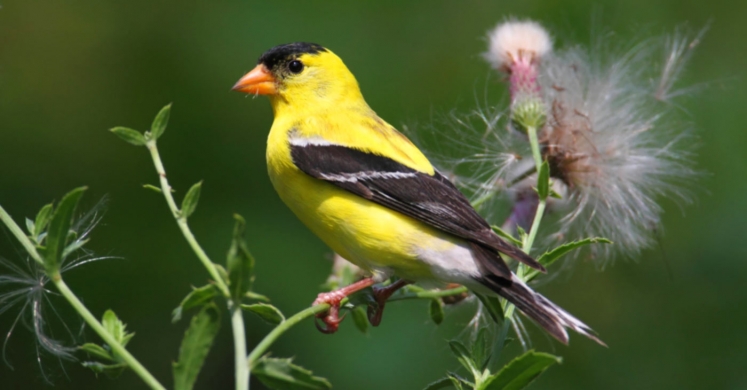Blog

#bioPGH Blog: Goldfinches
 A resource of Biophilia: Pittsburgh, #bioPGH is a weekly blog and social media series that aims to encourage both children and adults to reconnect with nature and enjoy what each of our distinctive seasons has to offer. From the best times to plant seasonal flora and enjoy their peak blooms, to astronomical events and creatures to keep an eye and ear out for, Phipps will keep you in the know with what’s going on in our environment!
A resource of Biophilia: Pittsburgh, #bioPGH is a weekly blog and social media series that aims to encourage both children and adults to reconnect with nature and enjoy what each of our distinctive seasons has to offer. From the best times to plant seasonal flora and enjoy their peak blooms, to astronomical events and creatures to keep an eye and ear out for, Phipps will keep you in the know with what’s going on in our environment!
While the male American Goldfinch (Spinus tristis) boasts the coloration of Pittsburgh’s beloved sports teams, this common native avian is actually the state bird of Iowa, New Jersey, and Washington. The male’s bright yellow plumage, black wings and forehead make it easily identifiable during the spring and summer months, however, as fall and winter approach both males and females of this species display dull-brown and black feather coloration to better blend with the changing foliage. Both male and female goldfinches are prevalent throughout our region and a common site during the fall as they are quite partial to the drying seed heads of cone flowers, thistle, sunflowers, and black-eyed Susans! Although it may sound a bit bizarre, with a diet that consists primarily of seeds, these finches also help propagate various species of native plants by distributing undigested seeds via their droppings. So if you happen to spot some lovely black-eyed Susans or sunflowers popping up in your garden next spring that you don’t quite recall planting yourself, it just might be that a goldfinch did it for you!
Connecting to the Outdoors Tip: While you might think you’re at a loss for good birdwatching opportunities in and around the city, Pittsburgh actually boasts several unique locations from which to view a variety of species, from the peregrine falcons that call the high-rises of Downtown home to the Hays bald eagles. Grab a pair of binoculars and a bike and hop on one of several trails surrounding the city for a better look at the several species of waterfowl, songbirds, and raptors that reside in the area. If you’d like to enjoy the birds from the comfort of your own home, however, consider crafting a bird feeder or two from recycled materials, such as old pie tins or soda bottles. Utilizing upcycled materials not only allows you to be as creative and custom as you would like with your designs but is also free of cost, and most importantly helps decrease the amount of reusable materials that makes it into the trash!
Continue the Conversation: Share your nature discoveries with our community by posting to Twitter and Instagram with hashtag #bioPGH, and R.S.V.P. to attend our next Biophilia: Pittsburgh meeting.
Additional Resources:
Audubon Field Guide - American Goldfinch
Cornell Lab of Ornithology - American Goldfinch
Birds & Blooms - How to Make a Bird Feeder

